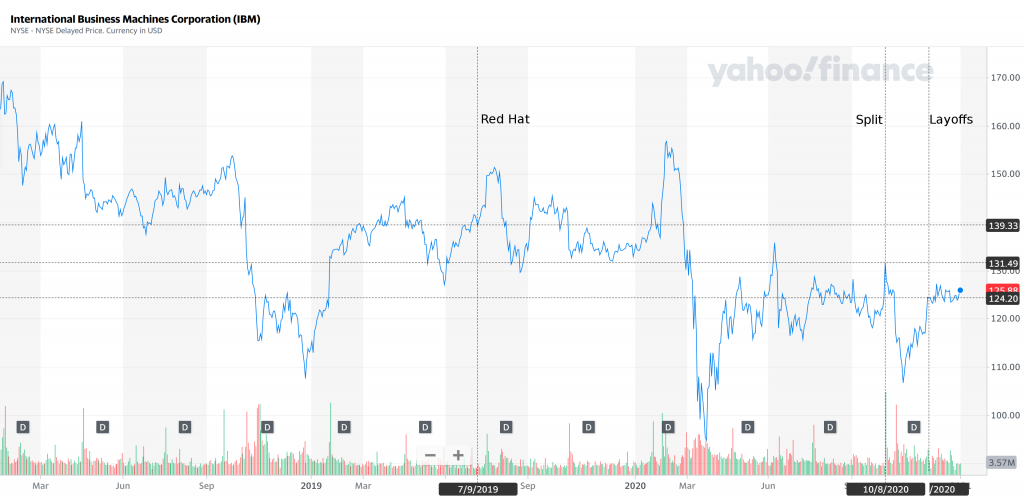Over the last two years, IBM has made a few… interesting… choices. Choices that seem… untypical… for them. Well, these decisions came from Arvind Krishna, who has since become CEO of IBM, so with some hindsight, everything does make sense in the big picture.
Contents
Acquiring Red Hat
It started with their acquisition of Red Hat (the popular Linux distributor) in 2019. I knew that Linux can run on mainframes, so it made sense to me that they would want to have their own Linux distribution. And in my opinion, Red Hat is – for IBM – the most logical choice: Red Hat is business-centric, very focussed on stability… and borderline uncool.
I even understand their decision to kill CentOS, Red Hats sister-distribution. After all, CentOS is Red Hat for free, just without commercial support.
Yes, they didn’t exactly kill CentOS – I know – but turining it into a rolling release is as good as killing it, because rolling releases don’t have the stability that CentOS users want from their distribution.
"Moving to India"
In early 2020, I read multiple reports about many job openings at IBM in India. Not long after that, I was surprised to read about massive layoffs in europe (IBM still has 340,000 employees worldwide).
I want to emphasize that the U.K. is explicitly mentioned as one of the countries that will be heavily affected by the layoffs. Consider that the CICS development team resides in Hursley, Hampshire, England.
I had heard about IBM moving 37.1% of their company to india before (in this summary of IBMs history). Further, 19.3% of their workforce were laid off between 2013 and 2018. And now this move means that another 2.9% are moved to India or laid off.
I can’t help but get the impression that IBM is slowly moving its entire company to India.
As a side-note, I want to mention one IBM employee who was laid off. He said that IBM fires the least productive employees every 6 months, which I find appalling.
He says: „it does feel good not having to worry about the semi-annual purges anymore. I sleep so much better at night as an ex-IBM’er. What puzzles me is the execs failing to understand how these constant layoffs are affecting the remaining workforce.“
Splitting into two companies
This third decision surprised me the most: IBM will split up into two companies. IBM itself will keep Red Hat and the Cloud-Business. Everything else becomes „Kyndryl“. In other words: Pre-2019-IBM will be renamed to „Kyndryl“, whereas Red Hat is renamed to „IBM“.
About the workforce, I only know that Kyndryl was supposed to get 90,000 (26.5%) employees, which leaves 250,000 employees for IBM. But of IBMs $50 billion, Kyndryl will only get $10 billion (20%), whereas IBM keeps $40 billion.
Wedbush Securities analyst Moshe Katri says: “IBM is essentially getting rid of a shrinking, low-margin operation given the cannibalizing impact of automation and cloud, masking stronger growth for the rest of the operation”.
Accordint to a more recent report, Kyndryl will get about 50% less employees than originally intended – at least from germany. If this decision translates to employees from other countries, this would potentially wreck Kyndryls capability of acting.
Conclusion
The difference in funding for both companies (20% of the money goes to 26.5% of the employees) makes me believe that Kyndryl will mainly get the India part of IBM (due to the smaller salaries there).
Now considering the recent layoffs and hirings, I guess that IBM has deliberately replaced experienced, but expensive workers to justify an even smaller part of the money for Kyndryl.
Putting all this together, it seems to me that IBM isn’t even trying to make Kyndryl viable. I guess that this is a stealthy termination of the mainframe business. I mean they turn that section into an under-staffed and under-financed separate company. Kyndryl is destined to go bankrupt quickly, taking the mainframe business with it.
Reactions of the Stock-Market
I can write articles and make predictions all day – what matters in the end is how these decisions impact IBM. From all I’ve seen, IBM seems to be solely interested in its stock-quote. So let’s see how all this affected their stock-quote.
After the acquisition of Red Hat, the stock-quote went up 8.6%, but this was in a phase where it had been rising similarly for 5 weeks. There is an interesting 14.6% jump up exactly on january 30th, 2020. That was the day Virginia Rometty resigned as CEO of IBM. Appointing Rometty as CEO was widely considered to be the biggest mistake in IBMs history, so that jump makes sense. The subsequent nosedive is probably due to the COVID-19 crisis, so I won’t hold that against anybody.
The layoffs were met with relative indifference. The split lead to an 18.9% plunge (which IBM quickly recovered from). Removing a less-profitable division should increase the averages, so this plunge is a bit surprising.
A few factors that might have played a role in this are:
- The split will cost $5bn
- IBM is pulling out of a market that it dominates
- IBM will mainly be in a market that is very much dominated by other companies (Amazon AWS, Microsoft Azure and Google Cloud)

